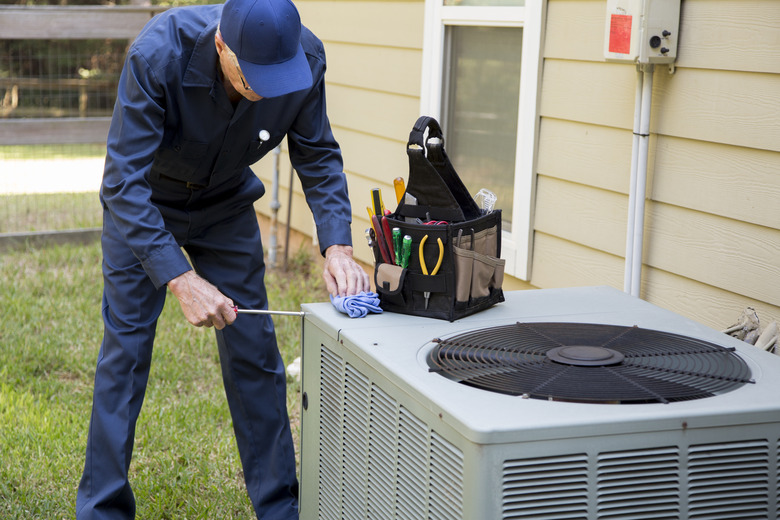How To Disconnect My Air Conditioner
If you're doing a little spring maintenance on your air conditioner, you should always disconnect the power first. Many homeowners also disconnect their air conditioners for the winter. This prevents the unit from accidentally kicking on during an unusually warm winter day. Exactly how you disconnect yours depends somewhat on the unit. Most turn off via a disconnect installed near the main unit. Some, however, rely on the breakers inside your electrical panel to turn them on and off.
At the Unit
At the Unit
Current building codes require that some type of disconnect switch be installed outside next to the air conditioning unit. The reason is so that a technician can easily confirm that the power is off before beginning work. It also keeps him near the shutoff switch so someone else doesn't unknowingly restore power while he is dealing with electrical components. Your air conditioner may not have this if it's a very old unit, but most appliances should.
You'll find this breaker box mounted on the outside of your home very near the air conditioner. When you open the box, you'll find the disconnect. One type of disconnect is the pull-out head. This tab pulls straight out of the socket and has four copper blades on the bottom. When inserted with the blades down, the pull-out head connects the power and shows the word "on" at the right side of the disconnect box. If you place it back in upside down, the power is disconnected, and the word "off" is visible on the left side of the box.
Some disconnects feature a simple on/off switch you can flip, while others use a double-pole breaker like those found in many fuse boxes. Simply flip the breaker switch to the on or off position as needed. If you see a knife breaker, open the circuit and turn the power off by swinging the knife handle up and away from the circuit breaker. (Knife breakers look a lot like the old paper cutter your teacher used in school.) You may also see fuses that need to be pulled out of the unit and "unplugged" to turn off the power.
At the Breaker Box
At the Breaker Box
If you have an older unit or can't find the shutoff switch outside, you can cut the power to your air conditioner from your home's main electrical panel. These panels are typically found in basements and garages but can be tucked just about anywhere. Ideally, you'll open the box, find neatly labeled circuit breakers, and can simply turn off the one for your A/C.
If your breakers aren't labeled (which happens far more often than it should), you have two options. The first is to simply flip off the main breaker to your home. If you're turning off your air conditioner to clean or repair it, this is a workable option. It's not feasible, however, if you're turning off your air conditioner for the winter.
In that case, you'll need to play the circuit breaker guessing game. Grab a partner and send him through the house. Have him tell you what turns off when you flip the breakers. Remember to label the breakers as you go so you don't have to play this game again later. Your air conditioner requires 240 volts, which means a pretty hefty circuit breaker. When trying to find the right breaker for yours, start with the larger double-pole breakers.
Complying With Electrical Code
Complying With Electrical Code
If you had to go the indoor circuit breaker route, be aware that your air conditioner is likely out of code. You don't necessarily need to do anything about it now. However, if you have electrical work done in the future or need your air conditioner serviced by a professional, local law may require you to install a code-compliant shutoff switch near the air conditioning unit itself at that time.
